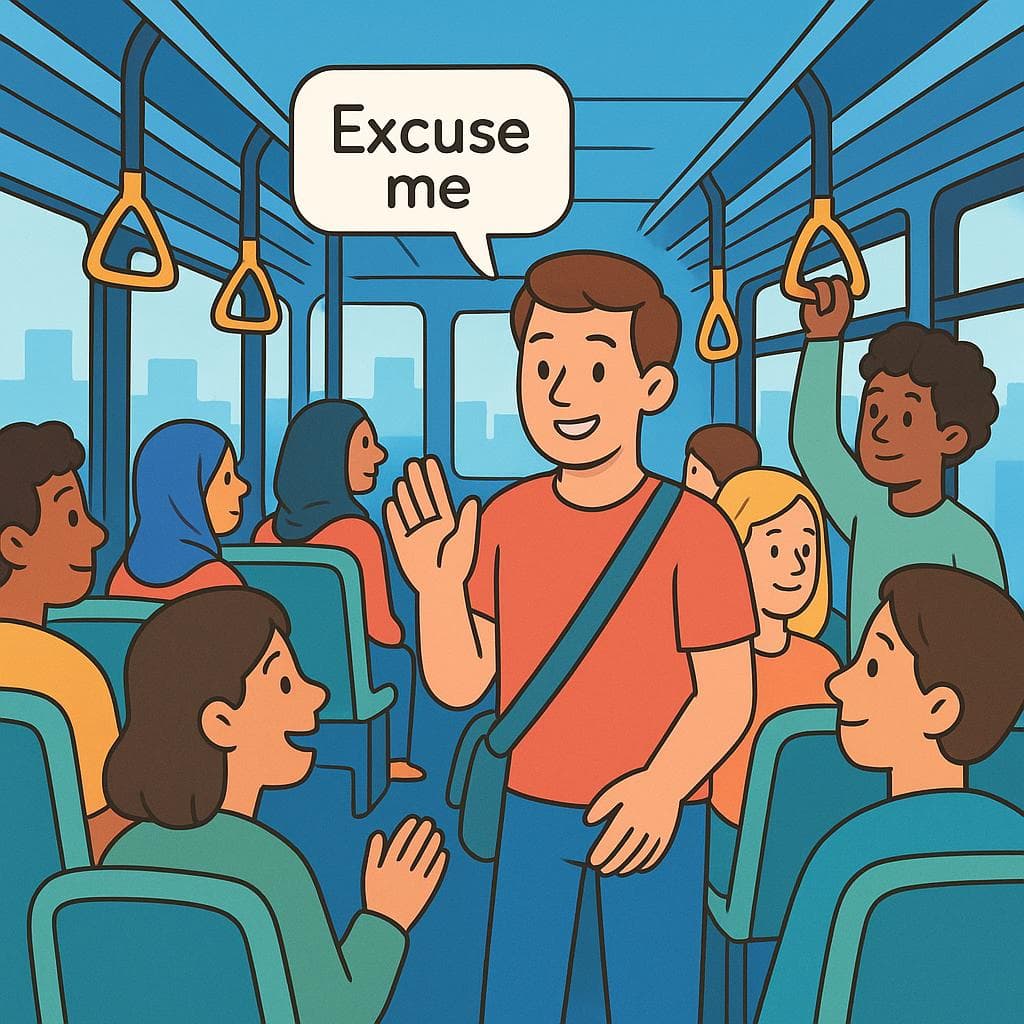Excuse me
in SpanishPerdón
/pehr-DOHN/
This is the most versatile and common way to say 'excuse me' or 'pardon.' It works for getting someone's attention, apologizing for a small mistake like bumping into someone, or interrupting.

When you need to get past someone in a crowded space, 'Con permiso' is the perfect phrase to use.
💬Other Ways to Say It
Con permiso
/kohn pehr-MEE-soh/
Literally 'with permission,' this is the go-to phrase for physically moving past someone or needing to get through a space they are occupying.
Disculpe
/dees-KOOL-peh/
A formal way to say 'excuse me,' used to get the attention of a stranger, an older person, or someone in a position of authority (the 'usted' form).
Disculpa
/dees-KOOL-pah/
The informal version of 'Disculpe' (the 'tú' form). It's used for the same reasons—getting attention or apologizing lightly—but with friends, family, or people your age.
Perdone
/pehr-DOH-neh/
The formal version of 'Perdón' (the 'usted' form). It functions almost identically to 'Disculpe' and is used to politely get attention or apologize.
Perdona
/pehr-DOH-nah/
The informal version of 'Perdón' (the 'tú' form), very similar to 'Disculpa.' It's a friendly way to apologize for something small or get a friend's attention.
Oiga
/OY-gah/
A very direct way to get someone's attention, literally meaning 'Hear!' or 'Listen!'. It's the formal 'usted' form.
Oye
/OY-eh/
The informal 'tú' version of 'Oiga.' It's extremely common among friends and is equivalent to saying 'Hey!' or 'Listen!' to get their attention.
Lo siento
/loh SYEHN-toh/
This means 'I'm sorry' and is used for more serious situations or to express sympathy. It's not typically used for minor things like bumping into someone.
🔑Key Words
Key Words to learn:
📊Quick Comparison
Choosing the right 'Excuse me' depends on your situation. Here’s a quick guide to the most common options.
| Phrase | Formality | Best For | Avoid When |
|---|---|---|---|
| Con permiso | Neutral | Physically passing someone or needing them to move. | Apologizing for a mistake or trying to get someone's attention to ask a question. |
| Perdón | Neutral | A quick apology for a minor mistake, like bumping into someone or sneezing. | You need to physically pass someone (use 'Con permiso' instead). |
| Disculpe | Formal | Politely getting the attention of a stranger, official, or elder to ask a question. | Talking to close friends or children, where 'Disculpa' would be more natural. |
| Oye / Oiga | Informal / Formal | Getting someone's attention from a distance or when they aren't looking at you. | Interrupting someone up close in a quiet setting; 'Disculpe' is more polite. |
📈Difficulty Level
The 'r' in 'perdón' and 'permiso' requires a slight tap of the tongue, but is generally easy for English speakers. The vowels are pure and consistent.
The main grammatical challenge is remembering the formal ('usted') vs. informal ('tú') versions, like 'disculpe' vs. 'disculpa'.
The biggest difficulty is not the words themselves, but knowing which one to use in the right context (passing vs. apologizing vs. getting attention). This requires practice and observation.
Key Challenges:
- Knowing when to use 'Con permiso' vs. 'Perdón'
- Choosing the correct formality level ('Disculpe' vs. 'Disculpa')
💡Examples in Action
Con permiso, voy a bajar en la próxima parada.
Excuse me, I'm getting off at the next stop.
Disculpe, señor, ¿me podría decir dónde está el baño?
Excuse me, sir, could you tell me where the bathroom is?
¡Uy, perdón! No te vi.
Oops, excuse me! I didn't see you.
Oye, Ana, ¿tienes un minuto?
Hey, Ana, do you have a minute?
Perdón que interrumpa, pero la reunión empieza en cinco minutos.
Excuse me for interrupting, but the meeting starts in five minutes.
🌍Cultural Context
Body vs. Action: The 'Permiso' vs. 'Perdón' Rule
Spanish makes a clear distinction that English blurs. 'Con permiso' is about your body needing space—you are asking for permission to pass. 'Perdón' or 'Disculpe' is about your actions—you are apologizing for an interruption or a mistake. Remembering this physical vs. actional difference is key to sounding natural.
Politeness is Paramount
In many Spanish-speaking cultures, using politeness markers like 'por favor' (please), 'gracias' (thank you), and the correct form of 'excuse me' is extremely important. Skipping 'con permiso' when passing someone can be seen as quite rude, much more so than in some English-speaking cultures.
The Power of 'Usted'
Choosing between the informal ('disculpa'/'perdona'/'oye') and formal ('disculpe'/'perdone'/'oiga') versions is a crucial social signal. When in doubt, always start with the formal 'usted' form ('Disculpe'). It's a sign of respect, and it's always better to be too formal than too familiar.
❌ Common Pitfalls
Using 'Lo Siento' for Everything
Mistake: "Saying 'Lo siento' after bumping into someone on the street."
Correction: Say 'Perdón' instead.
Mixing Up 'Perdón' and 'Con Permiso'
Mistake: "Saying 'Perdón' when you want to squeeze past someone on the subway."
Correction: Say 'Con permiso'.
Using 'Oye' with Strangers
Mistake: "Shouting 'Oye!' to get the attention of an older shopkeeper."
Correction: Use 'Disculpe' or 'Oiga'.
Forgetting Formality
Mistake: "Using 'Disculpa' when asking a police officer for help."
Correction: Use 'Disculpe'.
💡Pro Tips
The Three Scenarios Rule
To simplify, memorize three core scenarios. 1) Need to pass? Use 'Con permiso.' 2) Made a small mistake (bump, burp, sneeze)? Use 'Perdón.' 3) Need a stranger's attention? Use 'Disculpe.'
Combine with a Gesture
Your words are more effective with non-verbal cues. When saying 'Con permiso,' make a slight gesture with your hand indicating the direction you want to go. When saying 'Disculpe' to a waiter, try to make eye contact or give a small hand wave.
Listen for the Response
Pay attention to how people reply. If you say 'Con permiso,' they'll likely say 'Pase' or 'Adelante' (Go ahead). If you say 'Perdón,' they'll often say 'No pasa nada' or 'No hay problema' (No problem). This helps you learn the natural flow of conversation.
🗺️Regional Variations
Mexico
Mexicans are generally very polite in public spaces. 'Con permiso' is used almost automatically when passing anyone, even if they aren't directly in the way. 'Disculpe' is the standard, respectful way to address any stranger.
Spain
'Perdona' (tú) and 'Perdone' (usted) are extremely common for nearly all situations, including getting attention and apologizing. 'Oye' is used very frequently and casually among all age groups to grab attention.
Argentina
It's very common to drop the 'con' and simply say 'Permiso' when needing to pass. The 'voseo' form is used for informal address, so you'll hear 'Disculpá' instead of 'Disculpa'.
Caribbean (e.g., Cuba, Puerto Rico, Dominican Republic)
Speech is often very fast. You might hear the shortened, very colloquial 'Comper' as a quick version of 'Con permiso'. Politeness is still important, but the expression can be more abbreviated in casual contexts.
💬What Comes Next?
After you say 'Con permiso' to pass someone
Pase / Adelante
Go ahead / Come through
Gracias.
Thank you.
After you say 'Perdón' for bumping into them
No pasa nada / No hay problema
It's nothing / No problem
Gracias.
Thank you.
After you say 'Disculpe' to ask a question
Sí, dígame.
Yes, tell me?
Quisiera hacerle una pregunta...
I'd like to ask you a question...
🧠Memory Tricks
This direct link helps you reserve 'Con permiso' specifically for situations where you need to move through someone's personal space.
This is a direct cognate (a word that looks and means the same thing), making it easy to remember that 'Perdón' is your go-to for saying 'Pardon me' after a small mistake.
🔄How It Differs from English
The biggest difference is that English uses 'Excuse me' as a multi-tool for three distinct social situations: getting past someone, getting someone's attention, and making a small apology. Spanish demands more precision, using specific phrases ('Con permiso', 'Disculpe', 'Perdón') for each of these jobs. Mastering this distinction is one of the first major steps to sounding culturally fluent rather than just translated.
Spanish can be more direct when getting attention ('Oiga' literally means 'Hear!'), but is often more indirect in its structure of politeness. For example, 'Con permiso' ('With permission') is a more formal and structured request for space than the simple 'Excuse me'.
False Friends & Common Confusions:
Why it's different: English speakers often use 'sorry' very lightly, even for things that aren't their fault. The Spanish equivalent 'Lo siento' is much heavier and implies genuine regret or sympathy.
Use instead: For a light 'sorry' like bumping into someone, use 'Perdón'. Reserve 'Lo siento' for when you've made a real mistake or are offering condolences.
🎯Your Learning Path
➡️ Learn Next:
How to say please in Spanish
It's the natural companion to 'excuse me' in polite requests.
How to say thank you in Spanish
After someone helps you or lets you pass, you'll need to thank them.
How to say you're welcome in Spanish
Completes the politeness cycle; you'll hear this after saying 'Gracias'.
How to say I'm sorry in Spanish
Helps you understand the difference between a light apology ('Perdón') and a more serious one ('Lo siento').
✏️Test Your Knowledge
💡 Quick Quiz: Excuse me
Question 1 of 3
You are on a crowded train and need to get to the door for your stop. What should you say to the people in your way?
Frequently Asked Questions
What's the absolute main difference between 'perdón' and 'con permiso'?
Think of it this way: 'Con permiso' is for your body, and 'perdón' is for your actions. Use 'con permiso' when you need to move your body past someone. Use 'perdón' to apologize for an action, like interrupting, sneezing, or bumping into them.
Can I just use 'perdón' for everything to keep it simple?
While people will usually understand you, it will make you sound like a learner. Using 'con permiso' when passing someone is a very strong cultural norm in most Spanish-speaking countries. Making the effort to use the correct phrase shows respect and will help you sound much more natural.
Is 'disculpe' formal or informal?
'Disculpe' is the formal version, used with 'usted'. It's what you should use with strangers, elders, and in professional settings. The informal version, for friends and family (using 'tú'), is 'disculpa'.
When is it okay to yell 'Oye!' to get someone's attention?
'Oye' is best used with friends, family, or people your age, and often from a bit of a distance. Think of it as the equivalent of 'Hey!'. For strangers or in formal settings, a polite 'Disculpe' or 'Perdone' is much better.
Why can't I use 'lo siento' when I bump into someone?
You can, but it's like using a sledgehammer to crack a nut. 'Lo siento' carries more emotional weight, implying deep regret or sympathy. For a simple, everyday bump, a light 'perdón' is all that's needed. Using 'lo siento' might make the other person think the situation is more serious than it is.
Do I need to say 'con' before 'permiso'?
Saying 'Con permiso' is the most correct and universally understood form. However, in some regions, especially in casual speech in places like Argentina or Mexico, you will hear people simply say 'Permiso'. As a learner, sticking with 'Con permiso' is your safest and best bet.
📚Continue Learning Spanish Phrases
Explore More Phrases in These Categories
Find similar phrases to expand your Spanish vocabulary:
Want to Learn More Spanish Phrases?
Browse our complete collection of Spanish phrases organized by situation, from basic greetings to advanced conversations. Perfect for travelers, students, and anyone learning Spanish.
View All Spanish Phrases →
